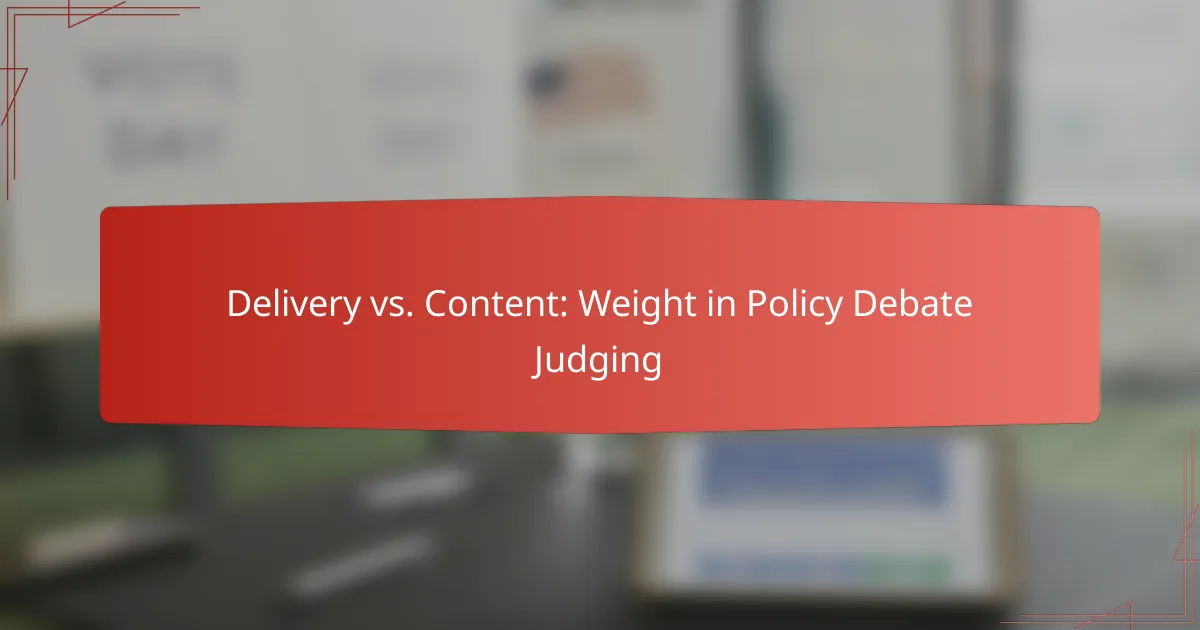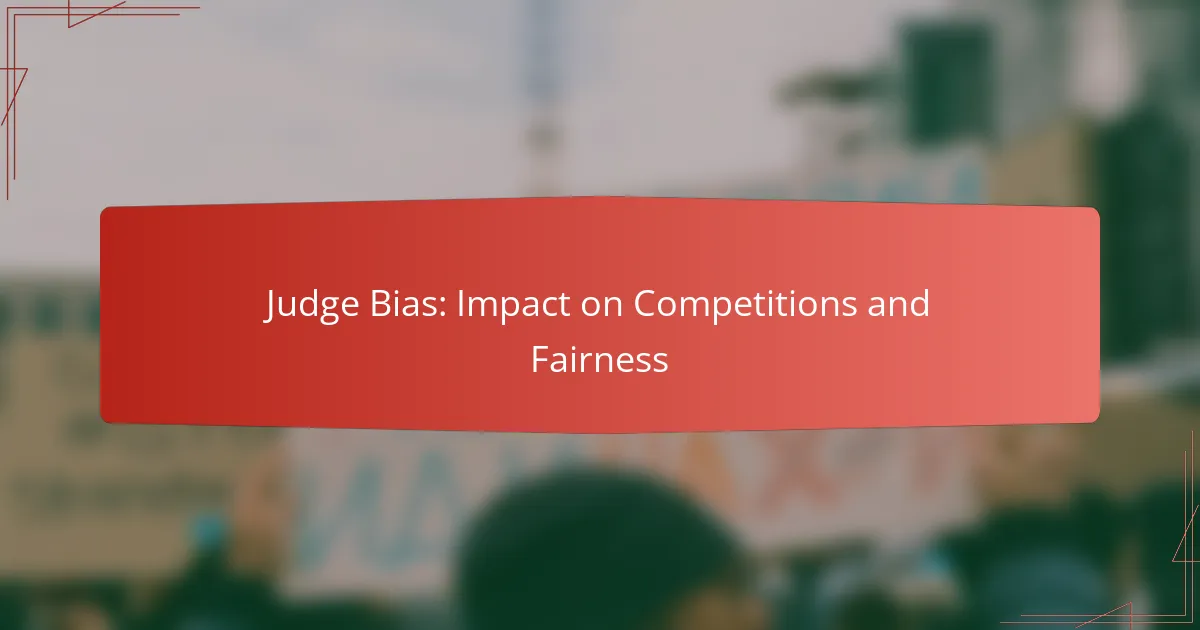In policy debate judging, the interplay between delivery and content is essential for evaluating a debater’s performance. While delivery encompasses aspects like clarity and engagement, content focuses on the strength and relevance of the arguments presented. Striking a balance between these two elements can significantly influence judges’ decisions and the overall effectiveness of a debate. Understanding their respective weights can help debaters refine their strategies for success.
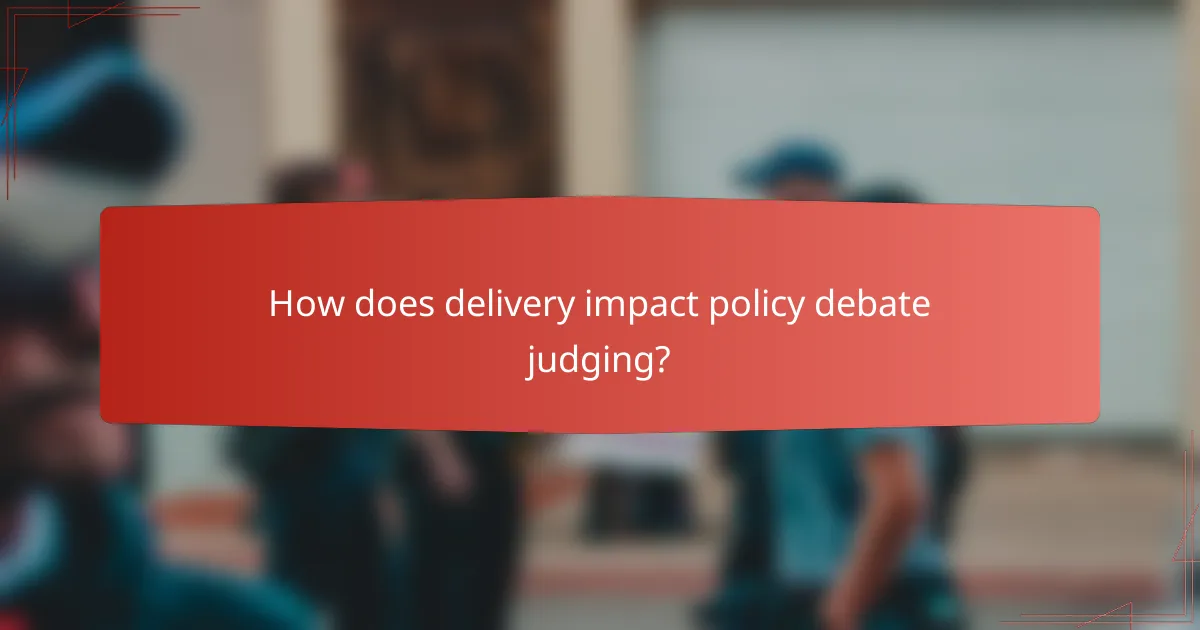
How does delivery impact policy debate judging?
Delivery significantly influences policy debate judging by affecting how arguments are perceived and evaluated. Judges often consider factors such as clarity, pacing, and engagement, which can sway their overall assessment of a debater’s performance.
Delivery as a key judging criterion
In policy debate, delivery is often a critical judging criterion alongside content. Judges look for effective communication skills that enhance the persuasiveness of arguments. A strong delivery can elevate a mediocre argument, while poor delivery can undermine even the best content.
Key elements of delivery include vocal variety, body language, and eye contact. Debaters should focus on these aspects to create a more compelling presentation that resonates with judges.
Influence of delivery on speaker perception
Delivery shapes how judges perceive a speaker’s credibility and confidence. A debater who speaks clearly and confidently is more likely to be viewed as knowledgeable and trustworthy. Conversely, a hesitant or unclear delivery can lead judges to question the validity of the arguments presented.
Moreover, effective delivery can enhance emotional appeal, making arguments more relatable. Engaging delivery can create a connection with the audience, which may positively influence the judges’ decision-making process.
Examples of delivery affecting outcomes
There are numerous instances where delivery has impacted debate outcomes. For example, a debater who uses strong vocal emphasis and varied pacing can highlight critical points, making them more memorable. In contrast, a monotonous delivery may cause judges to lose interest and overlook key arguments.
Additionally, body language plays a vital role; a debater who uses gestures effectively can reinforce their message, while a lack of engagement can detract from their credibility. Judges often remember the overall impression left by a debater’s delivery, which can be decisive in close rounds.
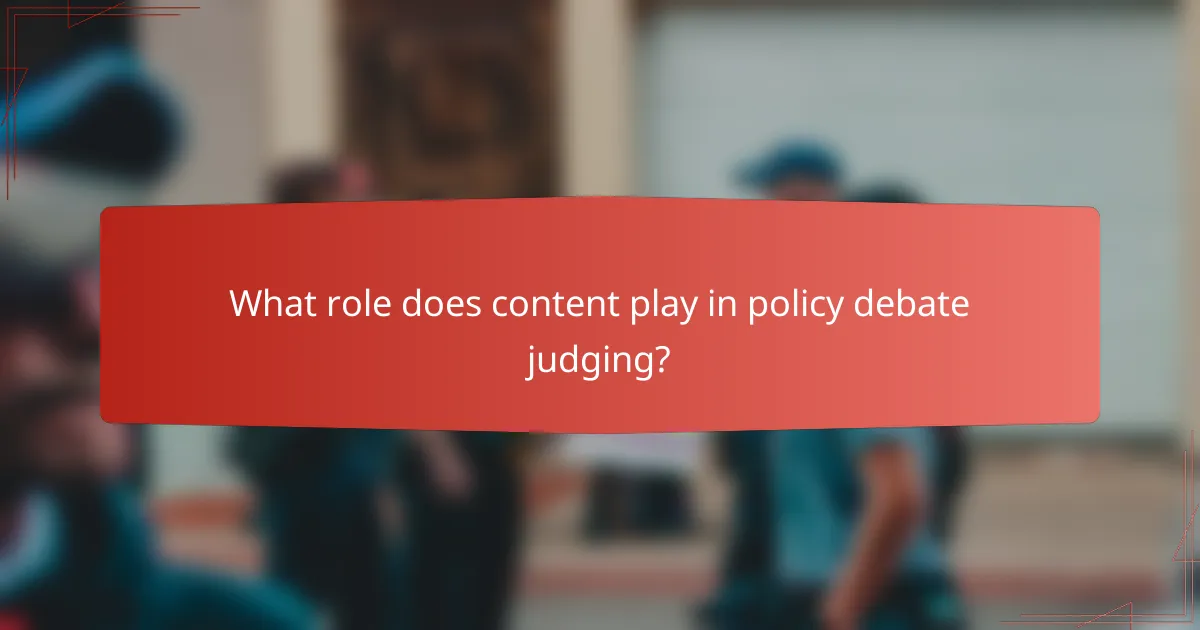
What role does content play in policy debate judging?
Content plays a crucial role in policy debate judging by determining the strength and relevance of arguments presented. Judges evaluate the quality of evidence, reasoning, and overall coherence of the content to make informed decisions about which side effectively supports its claims.
Content quality as a judging standard
Content quality serves as a primary standard in policy debate judging, influencing how judges assess the effectiveness of arguments. High-quality content is characterized by clarity, relevance, and depth, allowing judges to easily follow the debaters’ logic and reasoning.
Judges often look for well-structured arguments that are supported by credible evidence. This includes the use of reputable sources, clear definitions, and logical connections between claims and evidence. Debaters should focus on presenting their content in a way that highlights these qualities to improve their chances of winning.
Importance of evidence and argumentation
Evidence and argumentation are essential components of content in policy debates, as they provide the foundation for claims made by debaters. Strong evidence, such as statistics, expert testimonials, and case studies, enhances the credibility of arguments and persuades judges more effectively.
Debaters should prioritize using diverse types of evidence to support their claims, ensuring that their arguments are not only compelling but also well-rounded. Additionally, clear argumentation that logically connects evidence to claims is vital, as it helps judges understand the significance of the content being presented.
Case studies of content-driven debates
Case studies of content-driven debates illustrate the impact of strong content on judging outcomes. For instance, debates that feature well-researched arguments supported by empirical data often result in higher scores from judges compared to those relying on anecdotal evidence.
One notable example is a debate on climate policy where one team utilized comprehensive data from scientific reports, while the opposing team relied on general statements. The team with robust content not only won the debate but also received commendations for their thorough research and effective argumentation.

How do delivery and content compare in importance?
In policy debate judging, delivery and content are both crucial, but their importance can vary based on the context. Delivery encompasses the speaker’s style, clarity, and engagement, while content refers to the arguments and evidence presented. A strong balance between the two often leads to better outcomes in debates.
Judges’ perspectives on delivery vs. content
Judges often prioritize content when assessing the strength of arguments, but delivery can significantly influence their overall impression. A well-articulated argument can be undermined by poor delivery, while a compelling delivery can enhance weaker content. Many judges look for a combination of both to determine the winner.
Some judges may have personal biases towards delivery styles, which can affect their scoring. For instance, a judge who values charisma may reward a debater with strong delivery even if the content is less robust. Understanding the judging panel’s preferences can help debaters tailor their approach.
Statistical analysis of debate outcomes
Research indicates that debates with higher delivery scores often correlate with better overall performance, but content remains a critical factor. In many competitive settings, teams that score in the top percentile for both delivery and content tend to win more rounds. A balanced approach, where both elements are strong, typically yields the best results.
In some studies, debates where delivery scores were significantly higher than content scores showed a drop in win rates, suggesting that content cannot be overlooked. Debaters should aim for a delivery score that complements their content strength to maximize their chances of success.
Expert opinions on balancing delivery and content
Experts in debate coaching emphasize the need for a harmonious balance between delivery and content. They suggest that debaters practice both aspects equally to ensure they are prepared for various judging styles. A common recommendation is to rehearse speeches focusing on both the clarity of arguments and the effectiveness of delivery techniques.
Additionally, feedback from experienced judges can provide insights into how to improve both delivery and content. Debaters are encouraged to seek constructive criticism after rounds to identify areas for enhancement. This iterative process can lead to significant improvements in overall performance.

What frameworks help evaluate delivery and content?
To effectively evaluate delivery and content in policy debate judging, frameworks such as rubrics and scoring systems are essential. These frameworks help judges assess the effectiveness of a debater’s presentation and the quality of their arguments, ensuring a balanced evaluation process.
Criteria for effective delivery assessment
Effective delivery assessment criteria focus on aspects such as clarity, engagement, and pacing. Judges should consider how well a debater articulates their points, maintains eye contact, and uses body language to enhance their message. A strong delivery can significantly influence the persuasiveness of the arguments presented.
Common pitfalls in delivery include speaking too quickly, which can hinder comprehension, and failing to engage the audience, which may diminish the impact of the arguments. Debaters should practice their delivery to ensure they convey confidence and authority while remaining accessible to listeners.
Metrics for content evaluation
Content evaluation metrics should assess the relevance, depth, and organization of arguments. Judges can look for clear thesis statements, logical structure, and the use of evidence to support claims. High-quality content typically includes well-researched information and addresses counterarguments effectively.
To gauge content quality, judges may use a checklist that includes criteria such as the strength of evidence, clarity of reasoning, and the ability to connect arguments to broader policy implications. Debaters should aim to present content that is not only informative but also compelling and relevant to the debate topic.
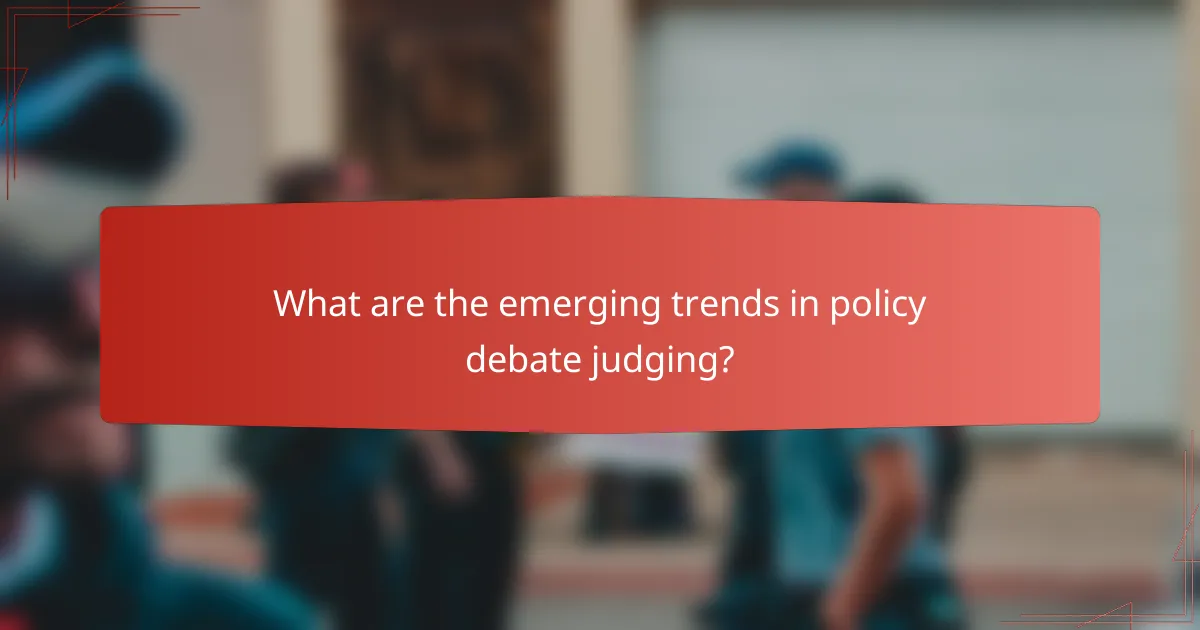
What are the emerging trends in policy debate judging?
Emerging trends in policy debate judging highlight a growing emphasis on both delivery and content. Judges are increasingly evaluating how effectively debaters communicate their arguments while also considering the substance of those arguments.
Impact of digital platforms on delivery
Digital platforms have transformed how debates are presented and judged, emphasizing the importance of delivery. Judges now assess debaters on their ability to engage audiences through video presentations, which can include elements like tone, pacing, and visual aids.
For instance, a debater who effectively uses multimedia tools may have an advantage over one who relies solely on spoken arguments. This shift necessitates that debaters adapt their delivery styles to suit online formats, often requiring practice in virtual environments.
Shifts in content expectations among judges
Judges are increasingly demanding higher quality and more nuanced content in policy debates. This trend reflects a broader understanding of complex issues, requiring debaters to present well-researched arguments that go beyond surface-level analysis.
Debaters should focus on integrating empirical evidence and real-world examples to support their claims. As judges prioritize depth and relevance, it is crucial for participants to stay informed about current events and policy changes that may impact their arguments.
Future of hybrid judging criteria
The future of policy debate judging is likely to incorporate hybrid criteria that balance delivery and content. This approach acknowledges that both elements are essential for effective communication and persuasive argumentation.
Debaters should prepare for a judging landscape where they must excel in both areas. This may involve practicing delivery techniques while simultaneously honing their research and analytical skills to ensure their content meets evolving standards.
